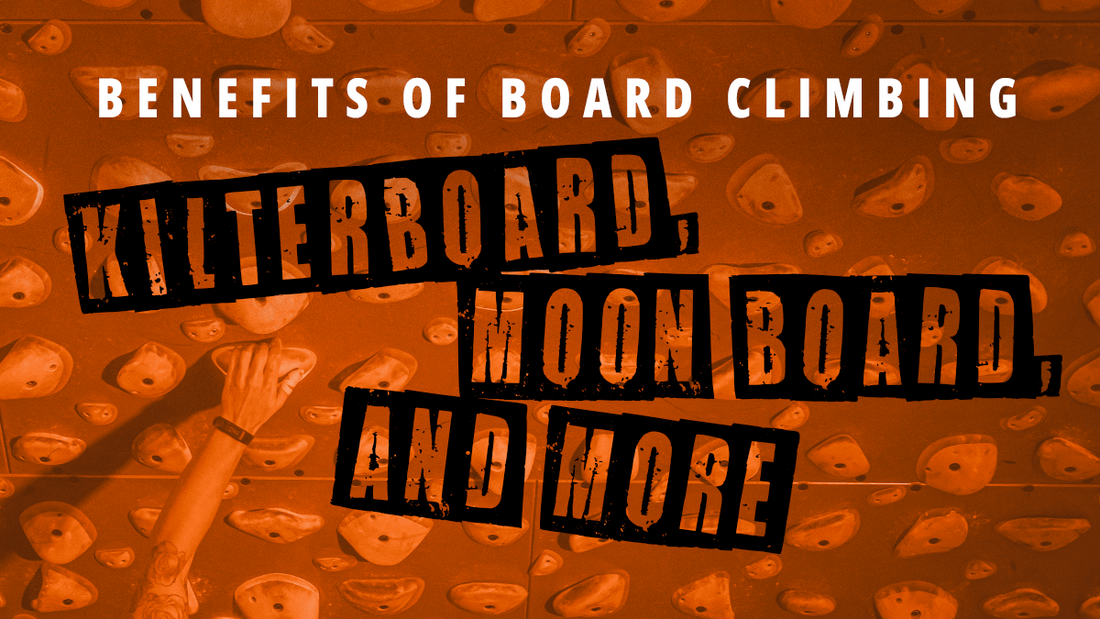
Benefits of Board Climbing: Kilterboard, Moon Board, and More
Share
Board climbing has become a cornerstone of modern climbing training. Many climbing gyms now feature Moon, Kilter, Grasshopper, or Tension Boards, some having more than one. These rightfully popular training tools offer a highly effective way to improve climbing performance. Whether you’re a beginner looking to build a strong foundation or an elite climber chasing the next grade, board climbing provides many benefits.
It’s worth noting that there are slight variations across the board types. However, the fundamental mechanisms are similar, extending benefits across all board types. The boards connect to a corresponding app that allows you to choose climbs. When a climber selects a boulder in the app, the corresponding hands and feet are visible on the training board via an LED system. Kilter, Grasshopper, and Tension Boards also allow for angle adjustment from 0 to 60 degrees, depending on the board. Moon Boards come in fixed 25 or 40-degree angles. With similar functionality, the benefits extend across all board types.

Breaking Down the Benefits of Board Climbing
1. Consistent Training
One advantage of board climbing is its repeatability. The mobile app and LED systems allow climbers to replicate and repeat exact routes set by others worldwide, allowing them to track progress on specific problems over time. Unlike outdoor climbing, where weather and rock conditions impact a session, board climbing ensures a controlled environment. This makes it easier to measure improvement and target weaknesses.
2. Customizable Difficulty
Board climbing can cater to climbers of all abilities. Climbers can tailor the board to match your current strength level and goals. Adjust the angle to a less steep setting and lower the grade range in the app. If there aren’t enough V2s, you can make up your own and add them to the library of boulders! These customization features ensure that climbers can continually progress, regardless of their starting point.
Board climbing provides a controlled environment for incrementally increasing the difficulty of boulder problems. In turn, the climber can gradually increase tendon and muscle strength with a lower risk of injury.
3. Improve Strength, Power, and Technique
Board climbing focuses on explosive movement and raw power, making it ideal for climbers seeking to improve their strength and dynamism. Regular sessions can
significantly enhance finger strength, core stability, and body tension. Board climbing also hones technique and movement patterns. The lack of features like aretes, extra surface area to smear, or intermediate holds forces climbers to move deliberately and precisely.
4. Efficient and Convenient
Board climbing is a game-changer for climbers looking to maximize their time in the gym. With a high concentration of boulder problems on one wall, you can climb more without moving areas. This is particularly beneficial for climbers with busy schedules. Additionally, board sessions require focus and intentionality. Sending board climbs demands short, intense bursts of effort, which can lead to significant gains if done correctly.
Board climbing also offers increased accessibility. Its compact designs fit into small spaces, and many climbers, especially pros, have installed Kilter or Moon Boards in their basements or garages. Integrating climbing into daily routines has never been easier. Even in gyms, boards are typically located in dedicated areas that are less crowded, ensuring you can train without interruption.
5. Community Engagement and Motivation
The global nature of boards via digital app interfaces means climbers can try boulder problems set by others worldwide and even share their creations. Competing against friends or joining online leaderboards can inspire climbers to push themselves and train consistently.
6. Preparation for Outdoor Projects
Board climbing can be a critical preparation tool for climbers looking to send a specific outdoor climb. The customization features allow a climber to simulate the style and difficulty of their project. Compared to rotating sets in a climbing gym, the lack of hold changes enables the repeatability of sequences and moves that simulate the outdoor climb. Using a training board in this capacity saves time and energy during outdoor sessions, allowing you to focus on sending rather than projecting.
Board climbing is a powerful and versatile training tool that offers numerous benefits for climbers. It’s a comprehensive, consistent, customizable, and efficient approach to improving climbing. Board climbing can target endless training goals, from increasing power and strength to improving technique to preparing for the end of an outdoor project. Integrating board climbing into a training routine can be the key to unlocking new levels of potential and staying motivated!
